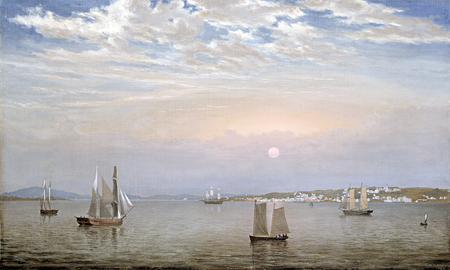Work of the Week #10
The water is calm and distant mountains are bathed in soft light. A nearly perfect sphere just to the right of the compositional center lets us know we are looking west. Judging by the layered pink and purple clouds, it promises to be a spectacular sunset. Daylight is waning, but the waterways formed by the meeting of the Bagaduce River and Penobscot Bay are surprisingly active. At least twelve boats of varying sizes and purposes are under sail in this scene. Clusters of straw-hatted men and bonneted women sit in the sterns of their pleasure craft. Solitary crew members stand on the decks of the commercial vessels, too. In the middle distance a patchwork of white, grey and mauve rectangles stretches across the hillside, at once mimicking the sails in the foreground and suggesting the neatly-organized village nestled around a quiet harbor. No doubt people are still at work there. Some might head home soon as a late summer day ends in Castine, Maine.
Fitz Henry Lane knew the pleasant rhythms of this place. Although he lived in Gloucester, Massachusetts, and had a disability since childhood that made travel over long distances hard, Lane went to Maine surprisingly often. The first record of his time in Castine dates from 1850. His closest friend, Joseph Lowe Stevens, Jr., was born in the shipbuilding community and Lane accepted an invitation from him to spend the summer there. He must have enjoyed the sojourn. Over the next decade, Lane returned on multiple occasions and produced dozens of works--lithographs, drawings, as well as large and small oil paintings--that celebrate the coastal town which was first settled by French explorers in the early 17th century and was later occupied by British forces during the War of 1812. The Museum of Fine Arts in Boston owns a large watercolor of Castine by Lane dated August 1851. Pieced together from two sheets of paper, it depicts the central section of our picture. We know from an inscription on the sketch itself that this particular view was made on a point of land directly across the estuary from the picturesque little town. The watercolor was judged so successful that it led to an important commission: the Timken’s painting by Lane.
For more than 125 years, Castine Harbor and Town was displayed in the local public library. Since its acquisition by the Putnam Foundation, in 1986, the work has hardly ever left San Diego. Once, in 1993, it traveled to a major retrospective of Lane’s work at the National Gallery of Art. Except for the small community of 19th-century American art specialists, not too many people know this particular work or its historic associations. Lately I have been imagining a focused exhibition dedicated to some of the artist’s finest images. Hopefully such a project would confer on our painting the kind of broad recognition that his other New England seascapes customarily receive. My dream project is on hold, temporarily, because of the current health crisis, but that fact does little to dampen my enthusiasm for this particular celebration of a summer evening. When we finally see Lane’s picture in context, surrounded by other similarly impressive representations, Castine Harbor and Town’s serene beauty will be magnified.
